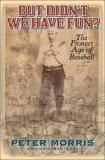


Baseball Toaster was unplugged on February 4, 2009.
Email me at btimmermann@gmail.com
Select a date:
 Peter Morris, who has been publishing baseball history works at a fairly good rate in past years, (Game of Inches and Level Playing Fields), has another entry this year in But Didn't We Have Fun: An Informal History of Baseball's Pioneer Era, 1843-1870.
Peter Morris, who has been publishing baseball history works at a fairly good rate in past years, (Game of Inches and Level Playing Fields), has another entry this year in But Didn't We Have Fun: An Informal History of Baseball's Pioneer Era, 1843-1870.
In this book, we get a look at baseball back when the game's rules were just being established. The game was becoming a sport. It was transforming itself from a recreational event to a competition. But the change in players' attitudes about how baseball should be played didn't happen overnight. Instead, there was a gradual transformation of the game to the game that we know today.
The years on each end mark the time when baseball's first rules are written down and widely publicized. These are the rules of the Knickerbocker Club of New York and Morris argues that they won the day, in part, because the club was very throrough about writing down events.
1870 marked the last year when there was no organized professional baseball league. In 1871, the National Association of Professional Baseball Players started play and the emphasis on baseball would be winning and not much else.
However, pioneer baseball wasn't always just a bunch of guys getting together on the village green for a glorified version of a modern day company softball game. Morris asserts that once there are written rules in a game, players quickly started looking for loopholes in the rules to exploit.
The classic case of this is one of baseball's first stars, Jim Creighton, who played for several clubs in the New York area right before the Civil War. Creighton trained hard with a steel ball so he could deliver a pitch as hard as possible under the rules of the day, which required an underhand throw with a stiff arm.
Creighton soon was throwing harder than any batter had seen. They flailed away at his pitches or at best popped them up. However, under the rules of the day, there were also no such things as balls or a strike zone. So batters decided to just wait out Creighton until he delivered a pitch to their liking. Morris recounts a game where Creighton threw over 300 pitches in three innings as batters waited him out for something they thought they could hit. (Creighton died in 1862 at the age of 21 of natural causes.)
There is a lot else to learn in the book. You can find out how the role of the umpire changed. The first umpires sat in a rocking chair with an umbrella for shade and was often given a glass of beer. Getting a game ball after a game was the ultimate prize in this era as they were hard to come by.
For most people who visit this blog, reading about baseball before the Civil War might seem to be incredibly arcane, but you can trace back the lineage of the sport we follow obsessively to a group of young New Yorkers who just wanted to get some fresh air and hit a ball around. And you can ask yourself: Is it still fun today? Isn't supposed to be?
Comment status: comments have been closed. Baseball Toaster is now out of business.